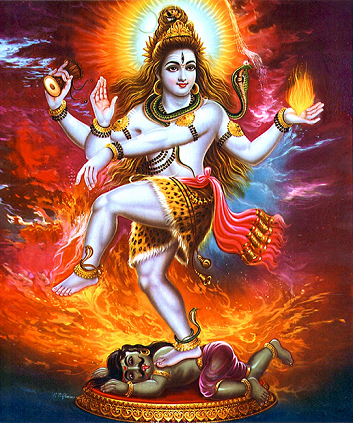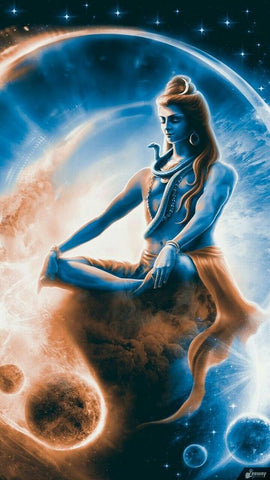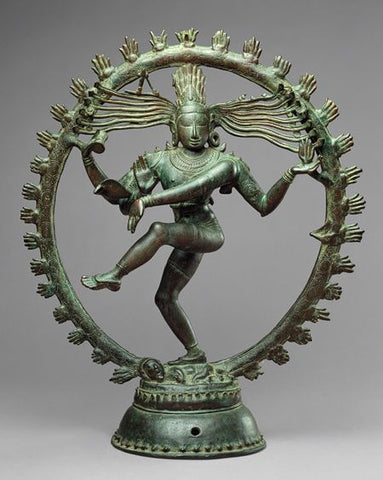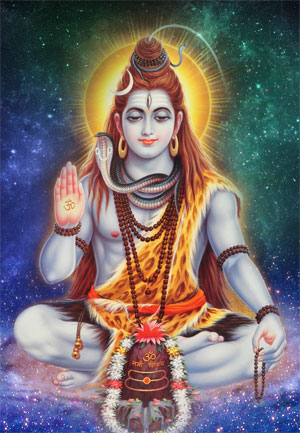January 08, 2020 0 Comments

Shiva is a complex Hindu Deity whose identity is inseparable from the Hindu Trimurti (or trinity) of Gods, composed of Brahma as Creator, Vishnu as Preserver, and Shiva as Destroyer. In that they are a trinity, neither of them is exclusively bound to the actions their names would imply, and instead each acts as a mask of inertia upon the stage that is life.
The role Shiva plays in the game of life is that of a juggler who effortlessly balances the opposing forces of creation and destruction, asceticism and procreation, stillness and dancing, order and chaos. There are myths that describe him appearing among mortals as a begging wanderer seducing the wives of evil sages, and also as a terrifying destroyer who lords over the burning grounds of cremation. He is known in one of his ascetic guises to have ignored his beloved feminine counterpart Shakti for thousands of years while she beckoningly danced for him, and yet in another state he is found playing out the folly of passionate grief in which he destroys the very God of desire whom enables romantic love to exist with his all consuming fire. As The Destroyer, Shiva’s role certainly conjures up much fear and animosity, but as we will see, his destructive force is ultimately a vehicle of liberation.
Shiva has over 1000 names, nearly all with different meanings and functions, so he can be very hard to pin down. Shiva means “Auspicious One” and his other names range from Mrityunjaya-”The One Who Conquers Death”, to Shambhu-”One Who Bestows Prosperity”, to Om Bhavaya Namah-”The God Who Is Existence Itself”, Kala-”Time”. He is said to be inextricably woven into all form, but does have a specific iconography which includes:
THE DANCE
Possibly the most well known image of Shiva is as the “Lord Of The Dance” or Nataraja, where he is shown ecstatically enraptured in the thrall of his own force, encircled by a ring of fire; A Cosmic Dance known as Ananda Tandava which translates to “Dance of Bliss” and implies a dance which begins with fierceness and ends in bliss. His dance is the animating force of the Universe. When portrayed as Nataraja, he is shown with his drum, a destructive flame in one hand, a protection Mudra with another hand, a raised leg symbolizing the hope of liberation, and the other leg standing upon a demon who represents ignorance and disorder, and the ring of fire which represents the successive cosmic cycles.
When Shiva dances the world is birthed or destroyed. When Shiva meditates the world disappears. If Shiva creates in ecstatic bliss, then he destroys the formless void. If Shiva destroys the world with raging fire, then the mortals are forced to release attachment to form, the liberation from desire, and to return to identification with the void, with the transcendent center of all possibility, also known as the Quantum Field. The void is where time does not exist, where Shiva is no longer keeping the rhythm of time going on his drum. The dance is also a metaphor for the process of spiritual transformation and our own personal cycles of death/rebirth, rest/inertia, etc,
With the current Saturn alignments we are likely feeling the pressure a Saturn’s restrictive force, his enforcement of deadlines, and the karmic debts he reveals when we have not been abiding by the laws of our soul-work. When we’re feeling the heaviness of time, and longing for it to stand still just so we can catch our breathe, it’s time to take a mediation break and meet Shiva in the void, where there is no time, no pressure, no rhythm, no “to do” list, no emails, and no desire ...there is only stillness and peace.
When we are stuck in old patterns, jobs we’ve outgrown, friends and relationships that are no longer in alignment with our current path, disempowering emotional patterns, even an old wardrobe that no longer suits us...then it’s time to dance with Shiva! The dance of destruction will help to burn away all that’s no longer serving you, and the dance of creation will help to bring forth the new.

Be forewarned, Shiva is a VERY powerful force to work with! Proceed with caution and reverence, and be prepared for massive transformation and shedding of skin when you work with The Destroyer!



Read more on astrology, horoscopes, occultism, magick & ritual on our blog, Esoteric Insights!
November 14, 2025 0 Comments
September 30, 2025 0 Comments
Are Labubus demonic? Are Labubus satanic? The internet loves a good conspiracy —especially when it involves something cute and strange. Recently, the Labubu doll became the subject of a bizarre claim: that it’s connected to ancient demons, specifically the Mesopotamian figure Pazuzu, made infamous in The Exorcist. Some Christian groups have even gone so far as to call the toy “satanic” or “possessed.” But is there any truth to this? Let’s dig into the symbolism, the different interpretations of “Satanism,” and how various spiritual traditions understand demons very differently.
July 05, 2025 0 Comments
As the Sun dips into the fiery heart of summer, July emerges—golden, long, and lazy. And right alongside it, the zodiac’s watery guardian, Cancer, takes the helm. July is one of the few month’s of the year (next to March or April, depending on the date of Ostara) where a pagan holiday or fire festival is not observed, yet the middle of summer seems almost ritualistic in how entrenched we become with the richness of the season. Looking further, it only makes sense as to why Cancer, summer’s sweetest star sign, is the mascot to the start of summer. Here’s why the vibrancy of July and the nurturing essence of Cancer are cosmic twins—bound by symbolism, season, and soul.